Sic Transit: On the Love of Portable Plants
“Cut flowers are often left at gravesites and at locations where sudden death has taken place. Their cutting and consequent wilting provides a symbolic parallel to the ephemerality of human existence and of the ties we make in our mortal lives. To be born is not only to leave the womb but to be severed from the umbilicus that makes each of us an embodied part of another. From then on, in a society of individuals, our lifespan depends on chance, our particular circumstances, and the slow cellular minuet of our embodied decay.”—William Ramp
Small Things Recollected
By William Ramp
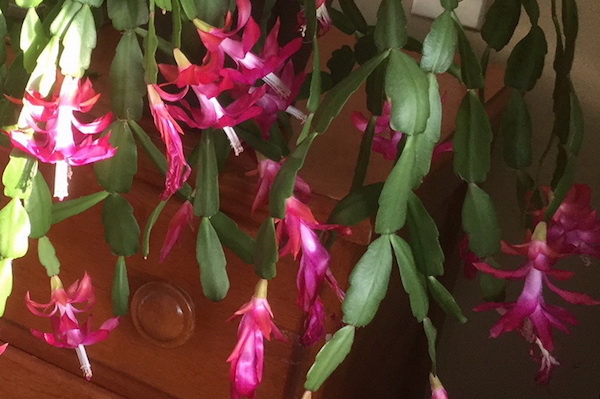
LETHBRIDGE, ALBERTA Canada—(Weekly Hubris)—July 2018— I began to write this column in April. According to the calendar, it was spring, but the sun struggled weakly to reduce the latest dump of snow, legacy of an extraordinary overstay of displaced polar air. The year was already out of sorts climatically and socially; there was no roaring concelebration of sunburnt and beery students on the final day of classes. The mood was subdued and anxious, reflecting the pressures of examinations and final assignments, job-seeking and packing. Leave-takings were tense and opportunities uncertain. Politicians and pundits parsed the latest political and fiscal atrocities, and someone referred, as someone has every year I can remember since 1973, to “these challenging economic times.” As if they were, somehow, still extraordinary.
Love and freedom were most definitely not in the air. It wasn’t the cruelest of Aprils, but it was certainly the greyest.
Nonetheless, friends on social media posted hopeful photos of snow-encrusted robins, ice-encased crocuses, and even suicidal early tulips, or Mourning Cloak butterflies huddling their shrouded wings under loose bark. Garden centers advertised their stock in vibrant color, urging the digging kind to be prepared for warmth and sun and hospitable soil just around the calendric corner.
I sat at home and graded papers, while in a patch of sunlight behind me, another untimely event slowly unfolded. In a Victorian wicker stand, a large Christmas cactus, Schlumbergera x buckleyi, belied its name, opening a new set of flowers and gently allowing others to wilt. I got up for more coffee, caught sight of it, and imagined that it was admonishing me: “In all your stress and worry and work, I am here, hoping quietly that you catch a glimpse of beauty that comes from no labor but life itself.”
In the modernist language of disenchanted human sciences, one could say I attributed that sentiment to a potted plant through a sort of psychological projection. But the feeling moved me as if it came from the cactus. Illusion or not, it strengthened a bond: a commitment to water and fertilize, and an acknowledgement of its second efflorescence as a sort of offering to which I must respond. Here, the present meditation began: how do affective ties between plants and people move both together to do specific things in particular settings, establishing relationships of feeling and meaning across time and space?
S. x buckleyi can yield, when the mood takes it, a profusion of flowers that combine graceful form, ethereal brightness, and delicacy of hue and detail. But it’s more than a mere repository of human aesthetic feeling. It exists today as a member of the cultural category “household potted plant” as a consequence of many different types of physical, intellectual, and emotional labor: colonial collecting, scientific and market-oriented propagation, settlement, home-making, and the preservation, observance and remembrance of embodied ties: love, kinship, household, locale, and displacement.
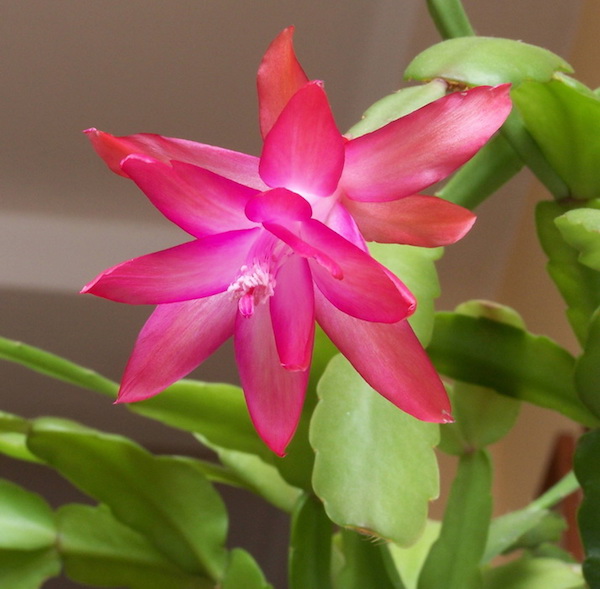
The keeping of house plants has a long and diverse history across several civilizations. The particular forms it takes in North America today have roots in Renaissance Europe, when exotic plants, kept in orangeries, became status symbols for the nobility and the wealthy. This was made possible by what Norbert Elias called a general pacification of society that, among other things, saw fortified houses and castles replaced as dwellings by palaces or aristocratic townhouses and country houses. It was also enabled by a thirst for exotic fauna and flora fueled by colonization and exploration.
These same developments resulted in the fashionable pastime of filling “cabinets of curiosities,” ancestors of modern museological, academic, and personal collections. They also provided the physical infrastructure for the industrious efforts at scientific botanical classification that attended the Enlightenment; efforts that depended on colonial rapacity and intellectual vanity as much as they did on dedication to the Republic of Letters or the ideals of a Royal Society.
The propagation and sale of domestic plants and the development of a myriad of new varieties by commercial nurseries was well-established in Britain by the dawn of the 18th century. But the keeping of exotic house plants as a mass phenomenon awaited the formation in the 19th century of a populous European middle class, along with developments in window architecture, home heating, iron and plate-glass construction techniques in greenhouses and conservatories, and steam transportation. The more popular and widespread the domestic-plant craze became, the more it became implicated in new forms of status differentiation. Plants sourced from local flora or exotics known for hardiness in sooty or dingy conditions (geraniums, for example) lost their cachet to more delicate tropical plants and hybrids, and were relegated to working-class windowsills. Interior decorators ever since have kept lists of “pariah plants” (the African violet, polka-dot plant, and rubber plant are all now to be avoided, apparently).
There is a tender cameo scene featured in both the 1912 book Greyfriars Bobby and in its 1961 Walt Disney film adaptation, in which the dying old shepherd spots a tiny potted plant on the sill of the garret in which he spends his final nights:
“Auld Jock set the jug and the candle on the floor and slipped off his boots. He had no wish to ‘wauken ‘is neebors.’ With nervous haste he threw back one of the windows on its hinges, reached across the wide stone ledge and brought in, wonder of wonders, in such a place a tiny earthen pot of heather!
“‘Is it no’ a bonny posie?’ he whispered to Bobby. With this cherished bit of the country that he had left behind him the April before in his hands, he sat down in the fireplace bed and lifted Bobby beside him. He sniffed at the red tuft of purple bloom fondly, and his old face blossomed into smiles. It was the secret thought of this, and of the hillward outlook from the little windows, that had ironed the lines from his face in Mr. Traill’s dining-room.”
The tiny, starved potted plant serves here as a vehicle of affect and nostalgia. Jock would never see his hills of heather again, but in his final hours in the callous world of the Edinburgh slums he would be comforted by their fragile representative: a plant separated, like him, from the hills of home. This scene would not have its latterly-Disneyfied power had not millions of readers and viewers identified it with their own experiences of caring for plants that meant more, often much more, than status markers or splashes of color; plants rooted in the soil of longing and loss.

While potted plants are identified with shelter, cut flowers are often left at gravesites and at exposed locations where sudden death has taken place. Their cutting and consequent wilting symbolically parallels the ephemerality of human life and of the ties we make in its span. To be born is not only to leave the womb but to be severed from the umbilicus that makes us an embodied part of another. From then on, particularly in a culture and economy predicated on individualism, our lifespan is measured by chance, our particular circumstances, and the slow cellular minuet of our embodied decay. But where regulations allow, gravesites also host a seasonal array of potted plants able to withstand the outdoors. My mother and aunts made yearly forays to a family burying-ground in spring and late summer to set them out and take them back in. Was their purpose to provide the dead with some imagined enjoyment of color? Maybe. But perhaps these acts also claimed the burial ground as domestic space, symbolically repatriating the memorialized dead by extending the sills of the living household, along with its prosaic work of potting, arranging and watering, to the foot of a distanced monument.
The Christmas cactus I remember from childhood was a hybrid, created sometime in the 1840s or early ‘50s by one Wilbraham Buckley, of Rollisson’s nurseries in the delightfully-named South London suburb of Tooting. Its parents were Schlumbergera truncata and Schlumbergera russelliana, both native to moist coastal mountain forests in southeastern Brazil, where they grow opportunistically (but not parasitically) on trees and rocks. Schlumbergera truncata was cultivated in Europe as early as 1818, but it was Buckley’s hybrids that took middle-class domestic life by storm in the 1860s, quickly populating heated greenhouses, conservatories, and household window sills.
It was not long before this segmented cactus came to Canada, as part of a world-wide circulation of plant material undertaken for commercial gain and as an accompaniment to agricultural and settlement colonization. In Canada, particularly in Ontario, seed and plant nurseries were set up well before the last forest giants were subjected to the axe, the stump-puller, and potash fires. From the beginning, these nurseries sold stock imported from British and European breeders, grafters, and cloners. Alongside them a more informal exchange flourished as settlers brought cuttings with them, swaddled to withstand eight weeks of Atlantic salt, or tried out varieties of corn, squash, beans, apples, peaches and a dozen other botanicals planted or orcharded by Mississaugas, Iroquois, and other original inhabitants. Much of this trade was in service of practicality; to supply the table or feed livestock. But it also included botanical specimens with no apparent human function other than to delight the eye or nose.
In the late 1860s, my maternal great-grandparents moved their family, their stock and themselves a hundred-odd Ontario miles from Hope Township, on the north shore of Lake Ontario, southeast to a fertile hundred acres outside the town of Woodstock, Ontario, the seat of Oxford County. The property came with a large brick house featuring a glassed-in conservatory on the west side, a perfect habitat for x Buckleyi. My great-grandmother set about populating that space with plants that would offset the chill grey of Upper Canadian autumns and springs.
Newer, fancier variants of Christmas and Easter cacti still populate the catalogs, but the classic coral-red x Buckleyi fell out of fashion in the 20th century. But many examples of it, bought in the 1870s and 1880s, have survived from cutting to cutting to the present. Easy to propagate, and cheering when they bloom in the dark days of December and January, they became carriers of affect and promoters of memory, even when no longer fashionable as decorative elements. Children and grandchildren inherited the large, woody originals or took away small, easy-to-root cuttings, as informal mnemonic talismans; living things that had once thrived under the touch of a mother or grandmother. All of the older variants of x Buckleyi probably trace their lineage through cuttings back more than 170 years to Buckley’s initial efforts.
And so, on her mother’s death in the early 1930s, my grandmother took in a Christmas cactus that had likely first entered the farmhouse conservatory in the 1870s and had survived relocation to a later retirement residence in Woodstock. I remember it spreading like a many-trunked tree, occupying pride of place in the bay window of my grandmother’s large, light-flooded dining room, along with a snake cactus and a huge fern (both likely with the same provenance).
Eventually, it moved again with my grandparents to their own retirement residence. I don’t know its present whereabouts, though it may be a monster I saw recently in the home of a surviving aunt. But my mom took a cutting from it when she married, rooted it and cared for it, giving it spells of tough love out-of-doors in summer. It, too, grew to vast proportions.
When my parents moved to a nearby care facility a dozen years ago, my mother’s Christmas cactus faced an uncertain future. It was too large for me to take back to Alberta from Ontario, or for my sisters to find room for. So, encouraged by the presence of many heirloom plants in the care facility foyer, I asked the wing administrator if they would accept the cactus as a donation. I was told, flatly, no. My dad and I smuggled it in anyway. It promptly disappeared.
But not before I had taken my own cutting, which survived a flight back to Lethbridge, a re-rooting, several subsequent tippings-over, forgettings-to-water, experimentations in canine gastronomy, and sub-dividings for friends foolhardy enough to express admiration.
And there it was, that April afternoon, in its pool of sunlight, next to a snake cactus that itself likely descends by subdivided propagation from the stately spikes of an ancestor that graced a farmhouse conservatory almost a century and a half ago.
![]()

Now, another story; another traveled plant: this one an outdoor shrub called a snowball bush, also in the family for well over a century.
Its vernacular name, so descriptive, prosaic, and jolly, did not indicate that I would have any trouble researching its botanical history and specification. But Wikipedia stumped me immediately, providing the following advice, unhelpful to the novice:
“Snowball bush is a common name for several ornamental plants which produce large clusters of white flowers and may refer to:
: Species of Hydrangea, which tend to flower in the summer—Hydrangea arborescens, Hydrangea paniculata
: Species of Viburnum, which tend to flower in the spring—Viburnum macrocephalum (Chinese snowball bush), Viburnum opulus (European snowball bush), Viburnum plicatum (Japanese snowball bush)”
I despaired until coincidentally my editor posted a photo of what I knew as a snowball bush to her Facebook page. I asked about it. She deferred immediately to heavy artillery: my Weekly Hubris colleague and doyen of most things botanical, William A. Balk, Jr. who sorted things smartly in a text message, as follows:
“Viburnum macrocephalum, almost certainly. Bill has it right . . . commonly ‘Snowball bush,’ ‘Chinese Snowball Tree,’ etc. Viburnum species produce a range of flowering forms, the ball-shaped inflorescence being only one of several; i.e. ‘Doublefile Viburnum.’ Of the species with globe shaped bloom heads, V. macrocephalum has the largest inflorescence. The listings for the plant’s size are, as usual, utterly frustrating for a gardener trying to plan for appropriately-sized plants at maturity: some describe the shrub as reaching 4′ x 5′ at maturity; as you have seen, in encouraging climates, they can easily reach 10′ or 15′ in any direction. The similarity of the blooming plant to Hydrangea macrophylla of the mophead type is often noted, but the flower heads on the hydrangea can reach much more massive size. The leaves of the big-leaf hydrangea and the big-head viburnum are quite different to each other, as well.”
That appeared to settle it. A shrub native to mainland China; I imagined it to have followed the paths of imperial adventurers, opium, and other traders, or missionaries, back to the nurseries of Europe.
However, the worm in the nomenclature flower turned almost immediately.
V. Macrocephalus is described as thriving only in climatic zones several hundred miles to the south of Southern Alberta, where my example had rooted and bloomed vigorously. Some further searching turned up another, more viable candidate: the look-alike Viburnum opulus ‘roseum,’ known in Europe since 1554, and planted at Monticello by Jefferson. This one is solidly European or, at the most, Eurasian; it has a long association with the Ukraine and was cultivated to the Dutch province of Gelderland (as the Guelder Rose) in the 17th century.
I can say with reasonable certainty that what I know as a snowball bush, a viburnum of some hardy and long-in-the-tooth sort, came to North America with settlers or their suppliers, as did the Christmas cactus, and thus that the latter-day history of the genus is similarly shaped by the colonial appropriation and parceling-out of First Nations land, and latterly by networks of European chain migration and settlement. Similarly, too, both its history and its nomenclature are rather tangled. (One local, looking at my specimen, stroked his chin wisely and averred with mystical but absolute certainty that what I had was, quite specifically, an “old-fashioned snowball bush.”) I take pleasure that my example, though sterile, is a relative of my favorite berry bush, the elderberry (not the ornamental varieties sold today, but the sort that has long grown wild in shade along rural Ontario field edges: areas I no longer venture into, sadly, as they house burgeoning populations of Lyme Disease-carrying ticks).
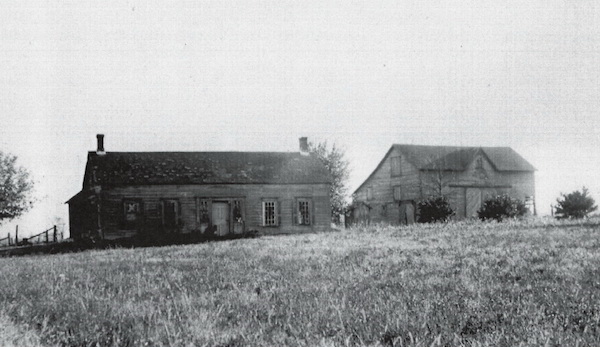
This is the story of my example. On the west side of an 1820s Ontario saltbox frame house, on a farm her husband bought in 1847, my great-great grandmother (in another line) tended a snowball bush that grew to impressive size. After her death, and that of her two farmer sons, ownership of the parental homestead was shared among surviving descendants and managed by my grandfather, who rented out the property and made a failed attempt or two to sell it in the depths of the Depression. He himself established a fruit orchard on a sand hill a mile or two up the road, turning his back on the pastured clay of the old farm. It may have been his interest in plant propagation, or perhaps a much-mediated sense of nostalgic guilt, that led him to dig up a portion of his grandmother’s snowball bush to re-establish on the front lawn of his new home.
By the most delightful of ironies, he finally succeeded in selling that old farm to his daughter’s husband, my father. In 1966, he sold his own orchard and moved into town. That same year, my parents built a new house on the old homestead (the sagging saltbox having been reduced to a pile of lumber and a stack of discarded doors and window frames). My mother made off with another dug-up portion of the relocated snowball bush and brought it back home.
A few decades later, as my parents contemplated retirement, I landed the most improbable of good fortunes (even then): a tenure-track teaching position in the province of Alberta, halfway across the second-largest country (in geographical size) on earth. When we bought a home there, I drafted my father and a shovel to wrench out a portion of the now twice-relocated snowball bush, and transported it to a new, semi-arid and alkaline environment. Improbably, it survived accidental mowing, children, and dog, and began, after an initial period of shock, to thrive.
Then we moved a few streets away to a larger house. The snowball bush was dug up again and replanted in the wettest corner of any yard in all Alberta. Again, improbably, it throve, and became gigantic, splashing out enormous white globules every May and June.
Then, a series of events occurred which I shall compress—a separation, a property sale, and two moves in different directions. Mine was to a small, rented condo unit in a development largely populated by students. (I entered my seventh decade living the same domestic life I’d lived as a depressed graduate student decades earlier.) In the flurry of the move, there was no time to dig up another piece of the much-traveled snowball bush, and no place in the condo development to relocate it to.
I snipped off several cuttings anyway, put them in a glass of water and hoped for the improbable. Against all odds, one rooted, and I moved it to a pot on my balcony for the summer, until I secured permission from my landlord to plant it beside the front door. It throve again . . . hesitantly, this time, but surely.
The following summer, I took an extended trip out of province. My return was not happy for some reason I have forgotten or blocked from mind. My daughter, who had been taking care of my place, ordered pizza for my arrival, and broke the news that she had successfully kept alive one of the several plants on my balcony. I was philosophical and forgiving. Then I thought to check on the tiny snowball bush outside.
It was gone.
Hands-and-knees searching revealed at last a tiny barren stump, snipped off an inch above ground. While I’d been away, the condominium yard-maintenance contractors had come through and had used a weed whacker to polish the area beside the front entrance. I whipped myself into an emotional tempest: some of my friends might still recall the screed I posted to Facebook in a non-cathartic rage. The next day, dully, I resolved to be mature and “let it go.”
In the final weeks of the fading summer of 2015, on a whim, I bent down to touch the almost-invisible remains of my failure. And, to my astonishment, I found the stub bearing a few microscopic leaves, already reddening into their fall coloration.
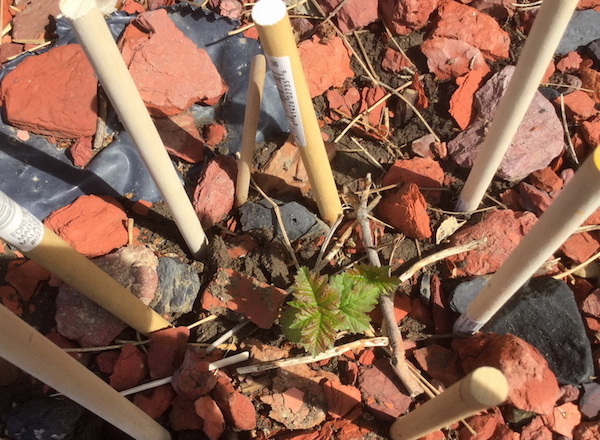
That was three years ago. I staked it with various configurations of wooden, and eventually metal palisades. The yard crew let it be. It survived the coldest days of the past winter, and I expect it this summer to top a foot or two in height and breadth.
It became the basis for now-embarrassing inspirational messaging on social media, mostly directed at myself. An example:
“This is a snowball bush.
It’s survived 135 years and —
— five moves over a total of 3500km
— two different climatic zones and several soils
— amateurish trimming, snipping, division & propagation
— thousands of hungry aphids and their ant-overseers
— an unsolicited neighborly application of herbicides
— obliterative weed-whacking by a clueless condo crew
Yet here it is, after last summer’s death pronouncement, poking out of the ground.
For one more try.
If it can . . . I can.”
And so on (I’ll spare you). I called it The Comeback Kid. I was going to include a photo of it in its present state, sporting its first-ever tiny globule of buds. But between this morning, when I had the thought, and this afternoon when I remembered to point a camera at it, this little artifact of settler colonialism met another artifact of the same. The establishment of cities on the North American plains, and the more recent development of green spaces in said cities, led to a vast population expansion of what is called, rather disingenuously, “urban wildlife.” A mule deer had chosen the tiny florescent snowball globule as an hors d’oeuvre. Alors, c’est la vie.
I’m sure many readers could give similar transplanting histories, typical of a genre, about many other old-fashioned shrubs and household plants: cacti, ferns, delphiniums, lilacs, forsythia, spirea, daffodils, irises. Even where stories have been lost, abandoned and overgrown shrubs and perennials join marching rows of maples and infantry squares of spruce to indicate where long gone farmhouses once stood on properties now cleared for development, given over to industrial-scale agriculture, or abandoned to scrub and reforestation. Sometimes, unmarked by property records, plants, trees, and shrubs give evidence of even older inhabitation. These are poignant left-behinds. But when house plants, slips, scions, cuttings accompany the leave-takers, they still speak of ties, if not actual places. To employ yet another loose psychoanalytic analogy, they serve as transitional objects of migration.
![]()
Every culture, and every great moment of social dislocation or transformation, gives rise to a set of mythologies which seek to reorient its members to their newly-given or appropriated dispensations; the particular dispositions of things, persons, gains, losses and encounters that make them who they are becoming. The process of conquering and settling the North American West generated several whose names are still familiar: Manifest Destiny; Progress; Amber Waves of Grain. Others, looking rearward in time and space, have various synonyms in settler literature: “the old homestead,” “the old country,” “back home,” etc. Let’s assemble their more extreme features into a cartoon called the Ancestral Village. There, nothing ever changes. No one leaves except for the emigrant. Family lines there run back to the dawn of time. Traditions date to the immemorial. Opportunity exists only outside the Ancestral Village. But it itself is an immovable point of departure and of fantasized return.
What sort of leave-taking generates such fantasies? It’s one thing to be forced from homes and land at the point of a gun or sword. Interestingly, stories of forced departure have been promoted and perpetuated—albeit selectively—within middle-class settler cultures founded by a healthy proportion of voluntary economic migrants. Many with Scottish ancestry have imbibed from the neat whiskey of the Highland Clearances, or have made claims that foreclosure, lack of economic opportunity or poverty are just as surely modes of “clearance” as the physical violence of the Sutherlands. And surely a follower of Polanyi or Marx must agree. But the more the emigration decision takes the shape of a decision—with remotely bearable alternatives—the more there are mixed feelings and ambivalences to be dealt with.
For migrants with some level of choice, Ancestral Villages usually had a shadow side: constraint, lack of opportunity; perhaps shame and status damage carefully hidden from descendants. Aspiration and opportunity could easily combine to fuel a self-justifying denigration of the cage one left. But each new departure could be interpreted as a blow. Those left behind suffered the loss of those who left, or aspired to follow them. Leave-taking and denigration can both impose the weight of betrayal, even if imagined. Eventually, nostalgia may become its salve.
Below is an excerpt from a letter written from Scotland to my 3 X great-grandfather, already in Canada, by his brother-in-law. It’s dated May 21, 1836. On that day, my ancestor’s children departed, at their father’s summons, from the letter-writer’s care. He wrote to them for another 20 years, occasionally plaintive that he and his wife had been forgotten. At first, his letters outlined plans for reunion and becoming a “laird in America.” Eventually, these gave way to a place-bound resignation. But the letters also detailed constant change in the old home village: the advent of gas lighting, arrivals and departures, political, institutional, and economic changes, buildings and infrastructure torn down and re-erected. The actual Village also left itself behind as it accommodated the seismic waves of Victorian capitalism.
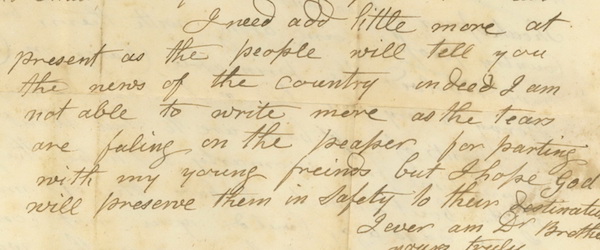
The Ancestral Village trope, then, is as popular in nostalgia as it is rare in actuality. Any local human community is constantly in a process of change. People are born, they die, they leave, they form new families and associations. There are incomers and travelers. The “family lines” that genealogists trace so lovingly are tangled networks of bifurcation. It is not only that the descent of people mixes memorialized community with the actuality of departures, separations, and recombinations. So does the transfer and division of property. The purpose of nostalgic tropes is precisely to bind up these wounds, and it is employed not only by emigrants but also by remainers: Gwen Kennedy Neville has written of how the Common Ridings of the towns and villages of the Scottish Borders celebrate past victories and re-enact communal boundaries in a way that constructs community as continuity and manages its ongoing disruption.
Thus, the liberation/nostalgia complex of economic migrants past and present can contain a dollop of guilt. By keeping memories and mementos of their places of origin, emigrants kept at bay the sense that they had abandoned their natal matrix; they honored it by remembering it, and they remembered it by caring for it in the form of mementos taken with them. Those removed the farthest in geography or in lifestyle were and are often the most avid of caretakers, sometimes publicly; often in secret. Those removed in time, the second or third generations, more easily shed the guilt but embrace nostalgia in more abstract popular-cultural forms that serve to reinforce the liberal individualism of settler morality.
Mementos are both children of and resistant to such generalized codes. In their keeping and care, they pull on general meanings but also recall specific places of origin and refurnish their owners’ adaptations to new settings. Pieces of china, photographs, a stone, a fruit-tree scion, a piece of rootstock, a cutting, a torn snapshot with a scrap of handwriting; these objects accrete significance through what anthropologists call ritual condensation, a process by which the particular and concrete comes to embody the abstract and general. Their survival as discrete artifacts is layered with definitions of communities, identities, friendships, enmities, moralities, and with passages between there and here, past and present. When such objects are kept primarily for those meanings rather than for use or consumption, they become, in the sense meant by Émile Durkheim, sacred, set apart, subject to interdictions that preserve a kind of power that inhabits them.
But this power is not exhausted by the symbolic meaning of mementos. They carry with them a freight of affect; they are vessels of feeling. We act toward them in ways that evoke or maintain feeling, but they also in a sense act back on us. As entities that we encounter and with which we develop relations of care and appreciation, they enable and constrain what we do, through and beyond their physical properties. As Bruno Latour has said, “to have a body is to learn to be affected, meaning ‘effectuated,’ moved, put into motion by other entities, humans or nonhumans.”
The point here is that the Ancestral Village and its related tropes are not mere illusions. They are not fabrications out of nothing. They are not merely symbolic. Their more particular truths reside in the practical co-implication of people and things; in an embodied production of meaning and feeling. They gesture toward a history but also result from and produce histories of their own.
An elderly neighbor from my childhood, during a single return trip to her birthplace in the former Yugoslavia (its Titoist realities disappointing to her in so many ways) managed to smuggle back with her some carefully-hidden poppy seeds of a highly-illegal sort. She propagated the resulting plants in a secluded area of her garden and told only a few about their existence. She put them to use in baking poppy-seed pastries (and only for that), claiming that only these seeds had the taste that she remembered. I doubt that anyone who did not share her origins could tell the difference, but the claim both legitimized the existence of the poppies (as “useful” plants) while concealing and revealing another reason for their being: they made possible the reanimation of continuity. The poppies gave her that through the mutually-entangled, embodied work of life and care: gardening, growing, ripening, harvesting, and baking. They acted as a taste talisman.
The word “talisman” in English dates to the 1630s, when it meant a “magical figure cut or engraved under certain observances.” That meaning connects the making to the magic: the figure is not carved routinely, but “under observances”: its formation is already an act of obedience both to its material and to its destiny. The term descends from the Byzantine Greek τέλεσμα, which layers notions of rite, ceremony, consecration and payment, and in turn from the ancient Greek telos, meaning “end, fulfillment, completion” of works of observance and payment; a labor of gift and return gift; of care. This labor involves encounters with the things cared for and, through them, with oneself, with others, and with the social circumstances of affection as they exist for people in particular settings, As Julie Soleil Archambault writes about Mozambican gardeners,
“An encounter, a meeting with someone or with something, is affective when it triggers some sort of effect; when it inspires, unsettles, troubles, moves, arouses, motivates, and/or impresses. If some affective encounters remain trivial, others can be life-changing. Encounters, in other words, are punctual events that can have enduring effects. Gardeners in Inhambane talk about how they came to love plants, about how they encountered plants—often after being introduced to gardening by a fellow gardener—and they also talk about more specific encounters with particular plants. Like any kind of encounter, affective encounters never take place in a vacuum. Rather, affective encounters are shaped by the particular sociohistorical geographies within which they are embedded. An anthropology of affective encounters takes everyday engagement with other-than-human beings and things seriously, while also paying careful attention to what such encounters produce.”
To tend to and pass on an heirloom plant is to navigate passages between loving others past and present through plants to becoming a lover of the plants themselves. Household plants depend on and respond to human care. They enable the gifting of affect and serve reciprocity and inheritance. Sometimes, they impose themselves as burdens. They not only speak to plant-lovers about other places and people; they are also encountered in their own right in moments of aesthetic appreciation, affection, and frustration. We feel rebuked when they wilt; guilty when they rot. We develop ties to them; we feel obligated to keep them alive, or to find somebody else who will do so if we can’t. I know people who cannot pass a thrown-out cutting without a pang and an urge to resuscitate it and give it a home. But plants do get thrown out and discarded; sometimes for reasons of décor; often because they have become inconvenient or overwhelming.
In the past decade or so, de-cluttering has become a popular-culture phenomenon; a promise of passage from overwhelm to overcoming. Marie Kondo’s famous sorting question for possessions, “Does it spark joy?” is repeated in innumerable books, articles, and memes. Just as models of retail exchange involving display of a cornucopia of actual stock in real space pass away, so too are status-conscious and aspirationally-mobile consumers being encouraged to transform their abodes into lifestyle display spaces containing carefully-curated collections of as little as possible; designer spaces, planes, contours, but not things. Plants, especially those which grow rapidly or in untidy ways, or which blossom profusely in the wrong colors, are not at all advantaged by this shift.
De-cluttering as aspirational self-improvement or lifestyle achievement is not the same as de-commodification. It establishes new ties between the commodification of personal and occupational life, and it normalizes lives of constant mobility in a way that both incites nostalgia and undermines its older, place-bound forms. Middle-class nostalgia now attaches more to consumer mementos of generational cohorts (millennials, boomers, “the nineties”) than to family lineages or place. And the slow fading of such decades and generations does not incite leave-taking guilt. But affective ties to close family, intimate partners, and friends whose trajectories diverge from ours do still invoke tensions between opportunity and loyalty, and the guilt or regret that attends the choice of one or the other. And so, talismans mutate in their symbolic and affective content but continue in their function. Such objects do more than spark joy or serve value-adding. They connect us still, if in new ways, to others who are not here. They connect us still to narratives; more provisional and experimental though they may be.
Some goodbyes are more painful and more conflicted than others. But after the fact, the more difficult partings can often be those in which one is left with memories but no mnemonic things. Whether the parting was good or bad may be less important than what one has something to remember a person or a place by. The digital age has made photographs more convenient to take and to carry, and they retain some talismanic aura. But the very ubiquity of the photograph, and its virtual form, make it less amenable to the development of rituals of care.
In the present age, we are urged to “get on” with things, to focus on the future and on our potential, and not to ruminate on or relive our losses. Beyond the obvious question of how age affects the relevance of such advice, I would suggest that it denies a basic human tendency to think and to feel wholes in parts, and to make and hold lines between us; lines that divide and bind, that ask for tending, that demand the care of markers.
If my Christmas cactus is thrown out at some point following my debility or death, or if it is left without the minimal water it needs in some busy office or apartment of the future, that will be all right. Lines of connection do not run on forever; ancestral villages dissolve, either into the kitschy mists of Brigadoon or into oblivion; these being effectively the same fate.
But I do aspire to leave a stealthy trail of snowball bushes wherever I reside, perhaps sparking thereby a moment of bemusement on the part of some future inhabitant. “What the hell is that proliferating thing? And where did it come from?”
![]()
References:
“The keeping of house plants has a long and diverse history …”
— Much of this discussion is based on Catherine Horwood’s Potted History: The Story of Plants in the Home (London: Frances Lincoln, 2007). See also https://www.catherinehorwood.com/ and https://www.scotsman.com/lifestyle/our-fascination-with-indoor-potted-plants-has-a-long-and-colourful-history-1-1072265
In addition to Horwood, see Trent Rhodes, “‘Of a Purely Decorative Nature’: Palm Plants in a Victorian Home,” Material Matters: Winterthur Program in American Material Culture, 2016.
“. . . what Norbert Elias called a general pacification of society . . .”
— See Norbert Elias, The Civilizing Process: Sociogenetic and Psychogenetic Investigations (Oxford: Blackwell, 2000)
“Interior decorators ever since have kept lists of “pariah plants . . .”
— See, e.g., Andy Sturgeon, House Plants (London: Conran, 2001). The African violet seems to be especially vilified online as an “old lady plant” or “grandma plant.”
“There is a tender scene in both the 1912 book and the 1961 Walt Disney film, ‘Greyfriars Bobby’ . . .”
— Eleanor Stackhouse Atkinson, Greyfriars Bobby (New & York & London: Harper & Brothers, 1912), Chapter III; online at https://en.wikisource.org/wiki/Greyfriars_Bobby/Chapter_III
“. . . created sometime in the 1840’s or early ‘50’s by one Wilbraham Buckley . . .”
— It owes the “Schlumbergera” portion of its name to the favoritism, rivalry, and sleight-of-hand typical of European collectors in the imperial era. In April, 1858, Charles Lemaire, a rather self-promoting academic botanist at the University of Ghent, published the name of a new genus, Schlumbergera epiphylloides, in L’Illustration Horticole, “a periodical of which he was editor and main contributor,” and the following month, in Revue Horticole, of which he was part-editor. The name supplanted a British designation, Epiphyllum russellianum, and honored a wealthy amateur cactus enthusiast, F[rédéric] Schlumberger, of Rouen, who may have had little to do with the specific genus that bore his name. See W. L Tjaden, “Charles Lemaire (1800-1871) and the Genus Schlumbergera,” The Cactus and Succulent Journal of Great Britain, 31(1), February, 1969.
See also Peter Coxhead, “Origin of the generic name Schlumbergera” (2011); Frederick William Burbidge, Cultivated Plants: Their Propagation and Improvement (Edinburgh & London: Blackwood & Sons, 1877), p. 223; Michel Combernoux, “History of Christmas Cactuses,” Epiphytic Cacti (n.d.), and Tina Bolin, “Will the Real Christmas Cactus Please Stand Up,” Dave’s Garden, (2012).
“. . . and a dozen other botanicals planted or orcharded by Mississaugas, Iroquois, and other original inhabitants . . .”
— See Helen Humphreys’ deservedly-bestselling The Ghost Orchard (HarperCollins, 2017)
“The property came with a large brick house featuring a glassed-in conservatory . . .”
— Formerly the childhood home of Margaret Beattie, wife of department-store magnate Timothy Eaton, and progenitor with him of a celebrated line of Canadian retail royalty
“. . . they became carriers of affect and promoters of memory . . .”
— See Kathleen H. Keeler, “Plant Story—a Christmas Cactus Named Junior,” and “Growing a Happy Christmas Cactus—Lessons from Junior,” A Wandering Botanist, February 2 and 14, 2014 and http://khkeeler.blogspot.ca/2014/02/growing-happy-christmas-cactus-lessons.html#more
“But Wikipedia stumped me immediately . . .”
— “Snowball Bush,” Wikipedia
“Viburnum macrocephalum, almost certainly.”
— William A. Balk to Elizabeth Boleman-Herring and William Ramp, personal communication, April 2018
“. . . known in Europe since 1554, and planted at Monticello by Jefferson …”
— See “Viburnum opulus ‘roseum’ – Snowball Bush Viburnum,” The Jefferson Encyclopedia, reproduced on The Jefferson Monticello (n.d.).
See also “Viburnum opulus ‘Roseum‘: European Snowball Viburnum” (n.d.), Classic Viburnums, and Julie A. Martens, “Snowball Viburnum,” diy network (n.d.).
“Sometimes, unmarked by property records, they give evidence of even older inhabitation.”
— See Helen Humphreys, The Ghost Orchard; also Veronique Greenwood, “Your Legacy on Earth May Be a Plant,” Nautilus, May 15, 2016.
See also Peter Melnycky, “Newton’s Lilacs: Edmonton’s Hermitage, 1876-1900,” RETROactive: Blogging Alberta’s Historic Places, May 23, 2018.
“Gwen Kennedy Neville has written of how the Common Ridings of the towns and villages of the Scottish Borders celebrate . . .”
— Gwen Kennedy Neville, The Mother Town: Civic Ritual, Symbol, and Experience in the Borders of Scotland (Oxford: Oxford University Press, 1994)
“. . . they remember it by caring for it . . .”
— Julie Soleil Archambault “Taking Love Seriously in Human-Plant Relations in Mozambique: Toward an Anthropology of Affective Encounters,” Cultural Anthropology 31.2 (2016).
“. . . what some anthropologists call markers of ritual condensation . . .”
— John Fiske and John Hartley, Reading Television (London: Methuen, 1978), 89-91
“. . . in the sense meant by Émile Durkheim, sacred, set apart . . .”
— Émile Durkheim, The Elementary Forms of Religious Life. A New Translation by Karen E. Fields (New York: Free Press, 1995)
“As Bruno Latour has said, ‘to have a body is to learn to be affected . . .’”
— Bruno Latour, “How to Talk About the Body? The Normative Dimension of Science Studies.” Body and Society 10:2–3 (2004), 205–29. Quoted in Archambault.
“The word “talisman” in English dates to the 1630s . . .”
— “Talisman (n.),” Online Etymology Dictionary.
“. . . works of observance and payment; a labor of gift and return gift . . .”
— I am thinking here of Marcel Mauss’s classic essay on exchange, reciprocity and recognition, “The Gift,” recently re-translated in an expanded edition published by HAU Books (Chicago, 2016).
“As Julie Soleil Archambault writes about Mozambican gardeners . . .”
— Julie Soleil Archambault “Taking Love Seriously in Human-Plant Relations in Mozambique: Toward an Anthropology of Affective Encounters,” Cultural Anthropology 31.2 (2016).
“Marie Kondo’s question, ‘Does it spark joy?’ . . .”
— See Marie Kondo, Konmari: Organize The World.
See also Kondo, Spark Joy: An Illustrated Master Class on the Art of Organizing and Tidying Up (Berkeley: Ten Speed Press, 2016). My thoughts on de-cluttering as a popular-culture phenomenon linked to economic and class transformations derive from a research project led by Dr. Davina DesRoches of the University of Winnipeg, in which I am a participant.
“. . . part of the modern gig-economy adage to travel light; to be “zero drag . . .”
— See Marcus Gilroy-Ware, Filling the Void: Emotion, Capitalism & Social Media (London: Repeater Books, 2017), chapter 3, and especially page 83; see also JRob, “Zero drag,” Urban Dictionary, 2005.
Images: 1: Author photo: Christmas cactus propagated by author; 2: Close-up photo of a cultivar of Schlumbergera Buckleyi Group by Lestat (Jan Mehlich), 2007, modified by Peter Coxhead, 2011. Source: Wikimedia Commons; licensed under Creative Commons Attribution-Share Alike 2.5 Generic license. See https://commons.wikimedia.org/wiki/File:Schlumbergera_Buckleyi_Group.jpg; 3: Edinburgh, Scotland: Headstone of Greyfriars Bobby, cropped from a photo by Stephen Montgomery, 2007. Source: Wikimedia Commons; licensed under Creative Commons Attribution-Share Alike 2.0 Generic license. See https://commons.wikimedia.org/wiki/File:Greyfriars_Bobby_Headstone.jpg; 4: Snowball flowers (Viburnum opulus Roseum). Photo by Fulvio Spada, 2014. Source: Wikimedia Commons; licensed under Creative Commons Attribution-Share Alike 2.0 Generic license. See https://commons.wikimedia.org/wiki/File:Snowball_flowers_(13985050634).jpg; 5: Photo from author’s collection; likely dating from between 1940 and 1955, when the house had become derelict. The tree behind and to the right of the house is most likely an apple, not the snowball bush mentioned in the column; 6: Author photo; 7: Author photo; document from author’s collection.
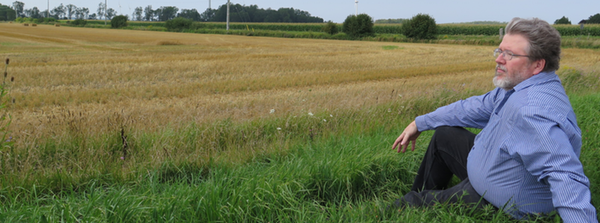

2 Comments
Will
Just wonderful, Bill! Thanks for writing this!
William Ramp
Thanks! Maybe I’ll follow up with an an Ode to the Elderberry sometime…